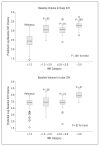Predictors of hematoma volume in deep and lobar supratentorial intracerebral hemorrhage
- PMID: 23733000
- PMCID: PMC3808840
- DOI: 10.1001/jamaneurol.2013.98
Predictors of hematoma volume in deep and lobar supratentorial intracerebral hemorrhage
Abstract
Importance: Hematoma volume is the strongest predictor of outcome in intracerebral hemorrhage (ICH). Despite known differences in the underlying biology between deep and lobar ICHs, limited data are available on location specificity of factors reported to affect hematoma volume.
Objective: To evaluate whether determinants of ICH volume differ by topography, we sought to estimate location-specific effects for potential predictors of this radiological outcome.
Design: Prospective cohort study.
Setting: Academic medical center.
Participants: A total of 744 supratentorial primary ICH patients (388 deep and 356 lobar) aged older than 18 years admitted between January 1, 2000, and December 31, 2010.
Main outcomes and measures: Intracerebral hemorrhage volume measured from the computed tomography scan obtained on presentation to the emergency department. Linear regression analysis, stratified by ICH location, was implemented to identify determinants of log-transformed ICH volume.
Results: Median ICH volume was larger in lobar hemorrhages (39 mL; interquartile range, 16-75 mL) than in deep hemorrhages (13 mL; interquartile range, 5-40 mL; P < .001). In multivariable linear regression, independent predictors of deep ICH volume were intensity of anticoagulation (β = 0.32; standard error [SE] = 0.08; P < .001; test for trend across 4 categories of the international normalized ratio), history of coronary artery disease (β = 0.33; SE = 0.17; P = .05), male sex (β = 0.28; SE = 0.14; P = .05), and age (β = -0.02; SE = 0.01; P = .001). Independent predictors of lobar ICH volume were intensity of anticoagulation (β = 0.14; SE = 0.06; P = .02) and antiplatelet treatment (β = 0.27; SE = 0.13; P = .03).
Conclusions and relevance: Predictors of hematoma volume only partially overlap between deep and lobar ICHs. These findings suggest that the mechanisms that determine the extent of bleeding differ for deep and lobar ICHs. Further studies are needed to characterize the specific biological pathways that underlie the observed associations.
Figures
References
-
- Broderick JP, Brott TG, Duldner JE, Tomsick T, Huster G. Volume of intracerebral hemorrhage: a powerful and easy-to-use predictor of 30-day mortality. Stroke. 1993;24(7):987–993. - PubMed
-
- Broderick JP, Diringer MN, Hill MD, et al. Recombinant Activated Factor VII Intracerebral Hemorrhage Trial Investigators Determinants of intracerebral hemorrhage growth: an exploratory analysis. Stroke. 2007;38(3):1072–1075. - PubMed
-
- Mayer SA, Brun NC, Begtrup K, et al. Recombinant Activated Factor VII Intracerebral Hemorrhage Trial Investigators Recombinant activated factor VII for acute intracerebral hemorrhage. N Engl J Med. 2005;352(8):777–785. - PubMed
Publication types
MeSH terms
Grants and funding
LinkOut - more resources
Full Text Sources
Other Literature Sources


